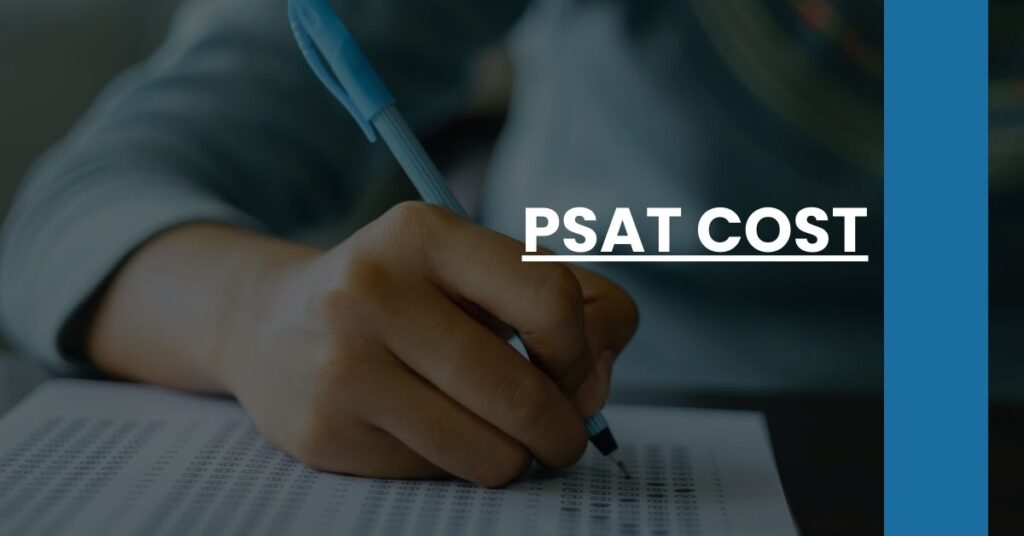The PSAT cost is typically around $18, varying slightly depending on your school or testing center. To manage these expenses better:
- Look into fee waivers if you qualify
- Plan ahead for financial aid options
Understanding the PSAT cost and planning for it can open doors to significant scholarship opportunities, making the investment well worth it.
Keep reading to explore detailed insights into managing and leveraging the PSAT cost for your educational advantage.
- Understanding the PSAT
- Breakdown of PSAT Costs
- Variation in PSAT Pricing
- Fee Waivers for PSAT
- Comparing PSAT Cost to Other Standardized Tests
- Financial Planning for PSAT Test Takers
- Understanding the Benefits of Investing in the PSAT
- Additional Considerations for International Students
- What to Do If You Can’t Afford the PSAT
- Resources and Support for PSAT Registration
- Conclusion: Is the PSAT Worth the Cost?
Understanding the PSAT
When you’re gearing up for your journey towards higher education, standardized testing is a critical milestone. The Preliminary SAT, more commonly known as the PSAT, is not just a practice run for the SAT—it’s a gateway to numerous opportunities. The PSAT serves several pivotal roles:
- Gauges College Readiness: It provides a benchmark for where you stand academically in preparation for college.
- Prepares for the SAT: The format and content mirror those of the SAT, aiding in familiarization.
- Opens Scholarship Doors: Perhaps most significantly, it can qualify you for the National Merit Scholarship Program, which is synonymous with prestigious recognition and financial aid.
Understanding the true value of the PSAT is crucial before you consider the cost. Taking this exam can be a smart investment, positioning you competitively for college admissions and scholarship opportunities. It’s important to view the PSAT not just as an expense but as a step towards unlocking your full potential.
Breakdown of PSAT Costs
Now, let’s talk numbers. The base fee for the PSAT, which usually hovers around $18, may seem minimal at first glance, but it’s essential to scrutinize what this entails and any additional costs that may apply. Typically, this fee includes the test booklet, scoring, and reporting. Some schools might charge a little extra to cover administrative expenses. How does your school handle it? It’s worth inquiring early to factor these costs into your budget.
Keep in mind the essential components covered by the base fee:
- Test Administration: Access to a proctored exam environment.
- Score Reporting: Detailed insights into your performance.
While it might be tempting to balk at yet another academic expense, remember that this is an investment. Think of it as a stepping stone that can lead to significant scholarships and college savings down the road. For an extensive explanation of what the PSAT offers, the College Board is a valuable resource.
Variation in PSAT Pricing
The PSAT cost isn’t a one-size-fits-all affair. Prices can vary depending on where you take the test, with some schools or districts absorbing a portion of the fee or even offering the test for free to encourage participation.
Furthermore, discounts might be available if you meet certain criteria:
- Are you enrolled in specific educational programs within your school?
- Does your school have funding allocations for standardized testing?
- Are there local community initiatives supporting educational advancement?
Understanding these variables can help you save money and still gain the invaluable experience the PSAT provides.
Fee Waivers for PSAT
If you’re facing financial hurdles, the PSAT fee waiver program could be a game-changer. The College Board ensures that students with financial need aren’t left behind by covering the full cost of the PSAT for those who qualify. Eligibility typically correlates with criteria like enrollment in the National School Lunch Program or meeting income guidelines.
Applying for a waiver is straightforward—you’ll usually need to speak with your school counselor, who can verify your eligibility and provide you with the necessary paperwork. When using a fee waiver, rest assured that you’ll receive the same testing experience and opportunities as those who pay out of pocket.
This isn’t just about taking a test for free; it’s about securing your future without financial barriers. To understand if you qualify, check out the College Board’s guidelines on fee waivers.
Comparing PSAT Cost to Other Standardized Tests
Putting the PSAT cost in perspective means looking at the bigger picture. Compared to the SAT and ACT, which can cost upwards of $50 to $70 (without essay sections), the PSAT is a more budget-friendly option. For instance, the fee for the SAT can reach $68 if you opt to take the essay portion, and the ACT ranges from $52 to $68, with the writing section.
The PSAT not only costs less but it can also be an essential tool in preparing for these more expensive tests. Take it as an investment in your future test performances, an opportunity to practice under real conditions without the higher stakes of the SAT or ACT. Plus, the PSAT can lead to scholarships that may substantially offset the costs of future tests and college expenses.
To see how the PSAT measures up against the SAT and ACT, Get Schooled offers a comprehensive comparison, outlining each test’s value, costs, and benefits. Make sure to compare these exams not just in terms of cost but also in terms of the opportunities they can unlock for your academic future.
Financial Planning for PSAT Test Takers
Managing your PSAT expenses doesn’t have to be daunting. With some forward-thinking and strategic planning, you can deftly navigate the psat cost and make it a manageable part of your educational budget.
Start by mapping out your standardized test timeline: Will you be taking the PSAT this year? How about the SAT or ACT next year? Remember, these costs can accumulate quickly, so it’s important to plan ahead. Here are some actionable tips to financial planning for the PSAT and beyond:
- Start Saving Early: A little bit saved each month can go a long way. Open a dedicated savings account for standardized testing fees.
- Look for Prep Resources: There are numerous free or low-cost PSAT prep resources. Leveraging these can reduce the need for expensive tutoring.
- Set a Budget: Include registration fees, study material costs, and potential travel expenses in your financial plan.
- Seek Out Fee Waivers: If eligible, apply for PSAT and SAT fee waivers to significantly cut down your expenses.
Keep in mind that investing time in preparation can save you money by potentially eliminating the need for retakes. For comprehensive budgeting advice, the Best Colleges side provides excellent resources.
Understanding the Benefits of Investing in the PSAT
You might be wondering, “Is the PSAT cost justifiable?” Let’s reassess the benefits. Beyond being a practice test, the PSAT can directly influence your financial future through scholarship opportunities. Qualifying for the National Merit Scholarship Program, for instance, could mean substantial financial assistance towards your college education. College readiness and the potential for scholarship awards are compelling reasons to consider the PSAT as a prudent investment.
Furthermore, your scores can help you target areas for improvement, leading to better performance on future exams. Ultimately, this can improve your college application, making you a strong candidate for other forms of financial aid and acceptance into more selective schools. The SAT Suite website is a treasure trove of information about how the PSAT connects you to scholarships and recognition programs.
Additional Considerations for International Students
If you’re an international student, some extra layers of financial planning are required when it comes to the PSAT. There might be additional fees for international testing locations, or you might need to travel to a nearby country where the PSAT is offered. Your preparation might also include exchange rate considerations and potential international transaction fees.
Pro Tip: Contact the testing centers well in advance to inquire about the specific costs and logistics involved. Start this process early to allow ample time for budgeting and making necessary arrangements. While additional resources specific to international testing are scarce, the College Board’s international students page offers guidance on standardized testing for international students, which can be a good starting point for your planning.
What to Do If You Can’t Afford the PSAT
Perhaps the PSAT cost is still outside your reach despite planning and saving. Don’t lose heart. Reach out to your school counselor—they may know of local scholarships, grants, or school funds designated for such purposes. Community organizations and nonprofits may also offer support for academically ambitious students facing financial constraints.
Remember, there are alternative pathways to college preparation. Online resources, community college courses, and study groups can offer effective, cost-efficient alternatives to traditional test preparation methods.
For insights on available financial aid and support mechanisms, the Critical Reader offers a realistic look at the financial aid landscape, including the potential benefits of being a National Merit Scholar.
Resources and Support for PSAT Registration
Feeling overwhelmed? You’re not alone. There’s a wealth of information available to help you navigate PSAT registration and manage costs. The College Board website is your go-to source for registration details, fee waivers, and a comprehensive rundown of what to expect. School counselors are also invaluable resources—they can guide you through the registration process, discuss financial aid options, and provide moral support.
To dive deeper into PSAT-related resources and support, visit the College Board’s dedicated PSAT registration page. }}”>
Conclusion: Is the PSAT Worth the Cost?
After dissecting the many facets of the PSAT cost, you might still be pondering whether the investment is worth it for you. Consider this: The PSAT is not just another exam—it’s a stepping stone towards a future of opportunities. It’s an affordable way to practice for higher-stakes tests, and the potential return on investment, whether in the form of scholarships or enhanced readiness for college admissions tests, is significant.
Ultimately, the decision is a personal one, but remember that education is an investment with the potential for life-changing returns. Your PSAT experience is more than just a test score—it’s an integral part of your academic trajectory that can open doors you never imagined possible.

